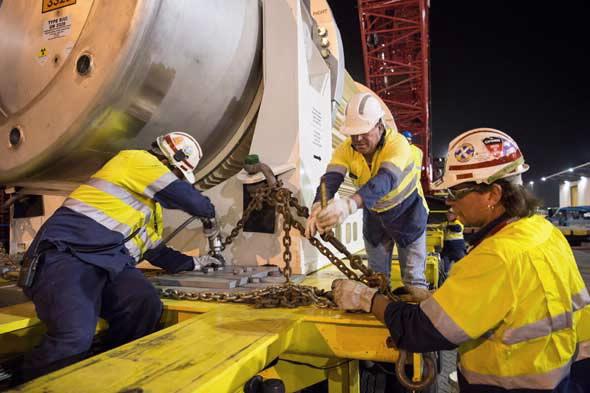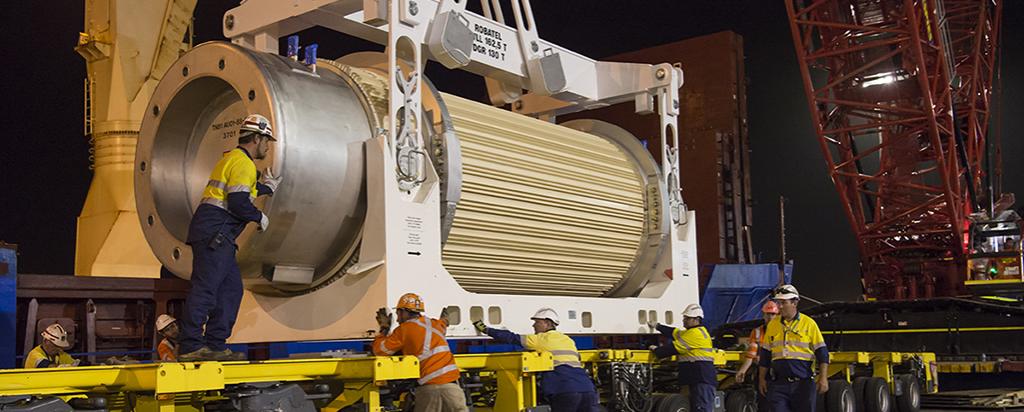

Published on the 6th December 2015 by ANSTO Staff
The Australian Nuclear Science and Technology Organisation (ANSTO) has confirmed the successful completion of phase one of the plan to repatriate Australian radioactive waste from France.
 |
Transport workers secure waste on a vehicle for the journey to Lucas Heights for temporary storage |
This Australian waste was a by-product of the generations of potentially life-saving nuclear medicine, as well as state-of-the-art nuclear research techniques to assist our environment, medical and mining industries.
Along with the significant benefits from Australia’s nuclear program comes a responsibility to safely manage the by-products, which is what we are doing here,” said ANSTO’s Head of Nuclear Services, Hef Griffiths, following the return of the waste.
The shipment of repatriated waste left France on 15 October, arrived in Port Kembla on 5 December, and was safely transported to the interim storage facility at Lucas Heights the following day (6 December, 2015).
ANSTO thanks the State and Federal Government agencies that were involved in “Operation Cormorant”, particularly the NSW Police and Australian Federal Police who have worked tirelessly on the repatriation.
The repatriated material will be temporarily held at ANSTO’s interim waste facility, which has been approved by all relevant regulatory agencies, until it is moved to the National Radioactive Waste Management Facility.
Radioactive waste is currently stored at more than 100 locations across Australia, including hospitals, mining sites and research centres, and a single national facility is in line with international best practice.
ANSTO welcomes the progress being made by the Federal Government in siting the National Radioactive Waste Management Facility,” said Mr Griffiths.
ANSTO is an organisation of innovation and experts, and has the experience and expertise to store this waste until the national facility is established.
According to the World Nuclear Association, since 1971 there have been some 7,000 shipments of spent fuel (over 80,000 tonnes) over millions of kilometres, without incident.
Media contact: Phil McCall 0438 619 987
BACKGROUND NOTES
Context
- For more than 60 years, Australia has benefited from the medical, minerals, environmental, and industrial research undertaken at Lucas Heights.
- One in two Australians will need a nuclear medicine diagnosis or treatment in their lifetime. 80% of that medicine comes from ANSTO, and 85% of our waste is associated with medicine production.
- Other benefits include:
- Increased efficiency of our mining industry, contributing to the Australian economy.
- Irradiation of silicon, used in fast trains, hybrid cars and solar farms.
- Ground-breaking research into the structure of materials ranging from batteries to proteins which makes a significant contribution to Australian innovation.
- A knowledge base that secures Australia’s position in the IAEA.
- Along with these benefits comes a responsibility to deal with by-products, including waste.
- Australia does not shy away from its responsibility that we have to take back our radioactive waste, and have it safely managed by experts in the field.
Where the waste came from
- In the 1990s, Australian Governments entered agreements with France, though which spent fuel from the old HIFAR reactor would be reprocessed by French experts.
- The French have the expertise to reprocess spent fuel, because of their extensive nuclear power program.
- In line with those agreements, and in line with French law, the waste left over from the reprocessing operation left France for Australia by the end of 2015. (It left on October 15).
Why it will be temporarily at ANSTO
- International best practice is that radioactive waste should be stored in a single, national facility that is geologically stable and safe, and built after consultation with the local community.
- Australia is in the process of establishing its own National Radioactive Waste Management Facility (NRWMF).
- Until that facility is sited, built and licensed, in line with international best practice, a temporary storage alternative is needed.
- ANSTO has the significant experience, security and expertise to act as a temporary storage site for its own wastes in the short term, but a purpose-built location is better in the long term.
- ANSTO is one of more than 100 locations that stores radioactive waste across the country – this also includes hospitals, mining sites and other research facilities.
- ANSTO is also incompatible long-term because of its location. Land uses in metropolitan areas change frequently, where this material will need to be stored for thousands of years.
About the container
- This transport container is made from forged steel and has walls that are more than 20cm thick.
- It is 6.5 metres long, 3 metres in diameter and weighs 95 tonnes when empty and 112 tonnes when loaded.
- It is shielded and able to contain radiation even under extreme conditions such as intense fire, shocks and drops, missiles and airstrikes.
- Each end of the container has impact limiters to protect it from high speed projectiles and crashes, withstand a drop of 9 metres, temperatures of about 800 degrees Celsius and a jet plane strike. In testing, similar containers have withstood crashes at 160km/hr.
- Based on radiation measurements taken as the container was loaded in France in October, if you sat on it for five hours, you would get the same radiation dose as in a flight to Singapore.
- Similar containers have been successfully used in 170 nuclear shipments around the world over 30 years.
Transport
- The waste left on 15 October 2015, on the nuclear-rated ship the BBC Shanghai, which was declared fit-for-purpose by Australian and French nuclear and maritime safety organisations.
- Once a National Radioactive Waste Management Facility has been sited, built and approved by regulatory bodies, the waste stored at Lucas Heights will be transferred to the NRWMF.
- According to the World Nuclear Association, since 1971 there have been some 7,000 shipments of spent fuel (over 80,000 tonnes) over millions of kilometres, without incident.